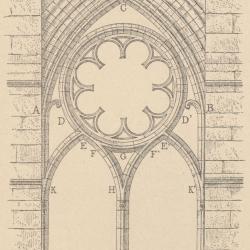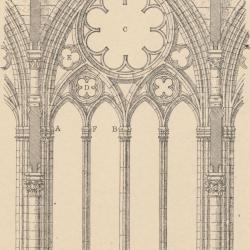Amiens Cathedral, northern flank of nave
This view of the northern flank of the nave at ground level would not have been possible in the early life of the cathedral when the collegiate church of S-Firmin the Confessor existed parallel to the cathedral nave.
Dedication of the chapels, left to right
1. St Agnes c. 1300
2. St Louis c. 1300
3. St Honoré c. 1300
4. St Michael, c.1350
5. St John Evangelist c 1375 (Cardinal Lagrange)
6. St John Baptist c. 1375 (Cardinal Lagrange)
Window Chronology
A study of the window tracery (the delicate stone armatures in the window openings) provides a useful index of chronology and authorship. Which window is earliest and which is latest?
1. The earliest window is in the lower level, extreme left, north transept. Inside a steeply-pointed arched frame a circular cusped oculus surmounts two lancets. The enormous window occupies the entire space between two buttresses: there is no wall. This is the work of the first master mason, Robert of Luzarches, 1220s
2. Each of the upper windows (clerestory) of the nave has a similar cusped oculus. There are now four lancets grouped in pairs, each pair capped by a smaller oculus. A strongly hierarchical arrangement. This is Master Thomas de Cormont, 1230s.
3. Between the 1290s and around 1400 the lower nave was expanded with the addition of a line of chapels. The chapels were built from east to west (left to right) with much more complex tracery forms. Note the horizontal bar (transom) in the middle of each window.


